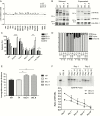Functional Analysis Reveals Geographical Variation in Inhibitory Immune Responses Against a Polymorphic Malaria Antigen
- PMID: 28605544
- PMCID: PMC5853457
- DOI: 10.1093/infdis/jix280
Functional Analysis Reveals Geographical Variation in Inhibitory Immune Responses Against a Polymorphic Malaria Antigen
Abstract
Background: Plasmodium falciparum reticulocyte-binding protein homologue 2b (PfRh2b) is an invasion ligand that is a potential blood-stage vaccine candidate antigen; however, a naturally occurring deletion within an immunogenic domain is present at high frequencies in Africa and has been associated with alternative invasion pathway usage. Standardized tools that provide antigenic specificity in in vitro assays are needed to functionally assess the neutralizing potential of humoral responses against malaria vaccine candidate antigens.
Methods: Transgenic parasite lines were generated to express the PfRh2b deletion. Total immunoglobulin G (IgG) from individuals residing in malaria-endemic regions in Tanzania, Senegal, and Mali were used in growth inhibition assays with transgenic parasite lines.
Results: While the PfRh2b deletion transgenic line showed no change in invasion pathway utilization compared to the wild-type in the absence of specific antibodies, it outgrew wild-type controls in competitive growth experiments. Inhibition differences with total IgG were observed in the different endemic sites, ranging from allele-specific inhibition to allele-independent inhibitory immune responses.
Conclusions: The PfRh2b deletion may allow the parasite to escape neutralizing antibody responses in some regions. This difference in geographical inhibition was revealed using transgenic methodologies, which provide valuable tools for functionally assessing neutralizing antibodies against vaccine-candidate antigens in regions with varying malaria endemicity.
Keywords: PfRh2b; growth inhibition; invasion; transgenic; vaccine.
© The Author 2017. Published by Oxford University Press for the Infectious Diseases Society of America. All rights reserved. For permissions, e-mail: journals.permissions@oup.com.
Figures



Similar articles
-
Blood-stage malaria vaccine candidate RH5.1/Matrix-M in healthy Tanzanian adults and children; an open-label, non-randomised, first-in-human, single-centre, phase 1b trial.Lancet Infect Dis. 2024 Oct;24(10):1105-1117. doi: 10.1016/S1473-3099(24)00312-8. Epub 2024 Jun 13. Lancet Infect Dis. 2024. PMID: 38880111 Clinical Trial.
-
The relationship between anti-merozoite antibodies and incidence of Plasmodium falciparum malaria: A systematic review and meta-analysis.PLoS Med. 2010 Jan 19;7(1):e1000218. doi: 10.1371/journal.pmed.1000218. PLoS Med. 2010. PMID: 20098724 Free PMC article.
-
A Diversity Covering (DiCo) Plasmodium vivax apical membrane antigen-1 vaccine adjuvanted with RFASE/RSL10 yields high levels of growth-inhibitory antibodies.Vaccine. 2024 Mar 7;42(7):1785-1792. doi: 10.1016/j.vaccine.2024.02.029. Epub 2024 Feb 16. Vaccine. 2024. PMID: 38365484
-
TLR9 gene polymorphism -1237T/C (rs5743836) is associated with low IgG antibody response against PvCSP variants in symptomatic P. vivax infections in Venezuela.PLoS Negl Trop Dis. 2025 Jun 30;19(6):e0013262. doi: 10.1371/journal.pntd.0013262. eCollection 2025 Jun. PLoS Negl Trop Dis. 2025. PMID: 40587574 Free PMC article.
-
Antibody tests for identification of current and past infection with SARS-CoV-2.Cochrane Database Syst Rev. 2022 Nov 17;11(11):CD013652. doi: 10.1002/14651858.CD013652.pub2. Cochrane Database Syst Rev. 2022. PMID: 36394900 Free PMC article.
Cited by
-
Fighting the SARS-CoV-2 pandemic requires a global approach to understanding the heterogeneity of vaccine responses.Nat Immunol. 2022 Mar;23(3):360-370. doi: 10.1038/s41590-022-01130-4. Epub 2022 Feb 24. Nat Immunol. 2022. PMID: 35210622 Review.
-
Development of Nested PCR-Heteroduplex Mobility Assay for Determination of Genetic Diversity in the Block 2 Region of the Plasmodium falciparum Merozoite Surface Protein 1 Gene.J Parasitol Res. 2020 Apr 8;2020:9520326. doi: 10.1155/2020/9520326. eCollection 2020. J Parasitol Res. 2020. PMID: 32328299 Free PMC article.
-
G6PD and HBB polymorphisms in the Senegalese population: prevalence, correlation with clinical malaria.PeerJ. 2022 Jul 5;10:e13487. doi: 10.7717/peerj.13487. eCollection 2022. PeerJ. 2022. PMID: 35811813 Free PMC article.
-
Semi-mechanistic population pharmacokinetic/pharmacodynamic modeling of a Plasmodium elongation factor 2 inhibitor cabamiquine for prevention and cure of malaria.Antimicrob Agents Chemother. 2023 Dec 14;67(12):e0089123. doi: 10.1128/aac.00891-23. Epub 2023 Nov 15. Antimicrob Agents Chemother. 2023. PMID: 37966273 Free PMC article.
References
-
- World Malaria Report Geneva, Switzerland: World Health Organization, 2015.
-
- Chotivanich K, Udomsangpetch R, Simpson JA et al. Parasite multiplication potential and the severity of falciparum malaria. J Infect Dis 2000; 181:1206–9. - PubMed
-
- Richards JS, Beeson JG. The future for blood-stage vaccines against malaria. Immunol Cell Biol 2009; 87:377–90. - PubMed
-
- Goodman AL, Draper SJ. Blood-stage malaria vaccines—recent progress and future challenges. Ann Trop Med Parasitol 2010; 104:189–211. - PubMed
Publication types
MeSH terms
Substances
Grants and funding
LinkOut - more resources
Full Text Sources
Other Literature Sources
Medical

